A Quantitative Study on the Impact of China’s Dual Credit Policy on the Development of New Energy Industry Based on Taylor Expansion Description and Cross-Entropy Theory
Abstract
:1. Introduction
2. Literature Review
3. Method and Proceeding
4. Data Analysis and Interpretation
5. Conclusions
Author Contributions
Funding
Data Availability Statement
Conflicts of Interest
References
- Zheng, J.; Zhao, H.; Li, Z. Research on R&D subsidies for new energy vehicle industry under Dual Credit Policy. Sci. Res. Manag. 2019, 40, 126–133. [Google Scholar] [CrossRef]
- Ou, S.; Lin, Z.; Qi, L.; Przesmitzki, S. The dual-credit policy: Quantifying the policy impact on plug-in electric vehicle sales and industry profits in China. Energy Policy 2018, 121, 597–610. [Google Scholar] [CrossRef]
- Zhu, Y. Optimization of Subsidy Strategies for the New Energy Vehicle Supply Chain under the Dual Credit Policy. Master’s Thesis, Qingdao University, Qingdao, China, 2020. Available online: https://kns.cnki.net/KCMS/detail/detail.aspx?dbname=CMFD202101&filename=1020384579.nh (accessed on 16 June 2020).
- Li, W.; Dai, L.; Guo, B.; Wu, S. Cooperative Innovation Game Analysis of Upstream and Downstream Enterprises in the New Energy Vehicle Industry under the Composite Traction Mechanism in the Post-Subsidy Era. Soft Sci. 2021, 35, 81–88. [Google Scholar] [CrossRef]
- Li, Y.; Zhang, L.; Liu, J.; Qiao, X. Can the Dual-Credit Policy Help China’s New Energy Vehicle Industry Achieve Corner Overtaking? Sustainability 2023, 15, 2406. [Google Scholar] [CrossRef]
- Liu, C.-L.; Zhao, L.; Li, J.; Gao, M.-Y.; Deng, X.-D. Analysis of New Energy Vehicle Production Decision Based on Optimal Control in the Context of Considering Cumulative Points and Carbon Trading. Comput. Integr. Manuf. Syst. 1–18. Available online: http://kns.cnki.net/kcms/detail/11.5946.TP.20220317.2003.005.html (accessed on 8 April 2022).
- Lu, C.; Wang, Q.; Chen, Q. Supply chain coordination of vehicles considering price, emission reduction, and range under the Dual Credit Policy. Syst. Eng. Theory Pract. 2021, 41, 2595–2608. [Google Scholar]
- Yu, X.H.; Ye, Z.X.; Li, M. Optimization analysis of two-level supply chain production decision under subsidy withdrawal-Dual Credit Policy. Oper. Res. Manag. 2021, 30, 42–49. [Google Scholar]
- Zhao, D. A Comparison and Implications of Development Policies for the New Energy Vehicle Industry in China and the United States. Knowl. Action 2021, 1, 45–48. [Google Scholar] [CrossRef]
- Rao, Y.; Shu, T. Analysis of Technological Innovation Behavior of New Energy Vehicle Enterprises Based on China’s Dual-Credit Policy. Manag. Rev. 2023, 35, 74–85+111. [Google Scholar] [CrossRef]
- Li, X.; Xiong, Y.Q. Analysis of the Impact of Dual Credit Policy on R&D investment of new energy vehicle enterprises. Sci. Res. 2021, 39, 1770–1780. [Google Scholar] [CrossRef]
- Cheng, Y.W.; Mu, D. Production decision optimization of automobile manufacturers under cumulative points system. Syst. Eng. Theory Pract. 2018, 38, 2817–2830. [Google Scholar]
- Li, X.; Xiong, Y.Q. Stages of the impact of the Dual Credit Policy on new energy vehicles from the perspective of both operational and environmental performance. Resour. Sci. 2021, 43, 1–11. [Google Scholar]
- Lu, Y.; Chen, H.; Liu, J. Analysis of the economic impact of the Dual Credit Policy on the development of China’s new energy vehicle industry. Chin. Foreign Entrep. 2019, 9, 121–122. [Google Scholar]
- Zang, W.; Zhang, Y.; Xu, L. A quantitative study of China’s artificial intelligence policy text--the current state of policy and frontier trends. Sci. Technol. Prog. Countermeas. 2021, 38, 125–134. [Google Scholar]
- Abotah, R.; Daim, T.U. Towards building a multi-perspective policy development framework for transition into renewable energy. Sustain. Energy Technol. Assess. 2017, 21, 67–88. [Google Scholar] [CrossRef]
- Blaszczyk, M.; Jantos, D.R.; Junker, P. Application of Taylor series combined with the weighted least square method to thermodynamic topology optimization. Comput. Methods Appl. Mech. Eng. 2022, 393, 114698. [Google Scholar] [CrossRef]
- Qiao, J.; Yang, S.; Chen, Z.; Zhuang, Z.; Chen, L. A quantitative study of policy-driven changes and forecasts in the development of the hydrogen transportation industry. Energy Rep. 2022, 8 (Suppl. 4), 1218–1225. [Google Scholar] [CrossRef]
- Li, X. Scientific and Technological Progress, Economic Growth and Hilbert Space; People’s Publishing House: Beijing, China, 2014. [Google Scholar]
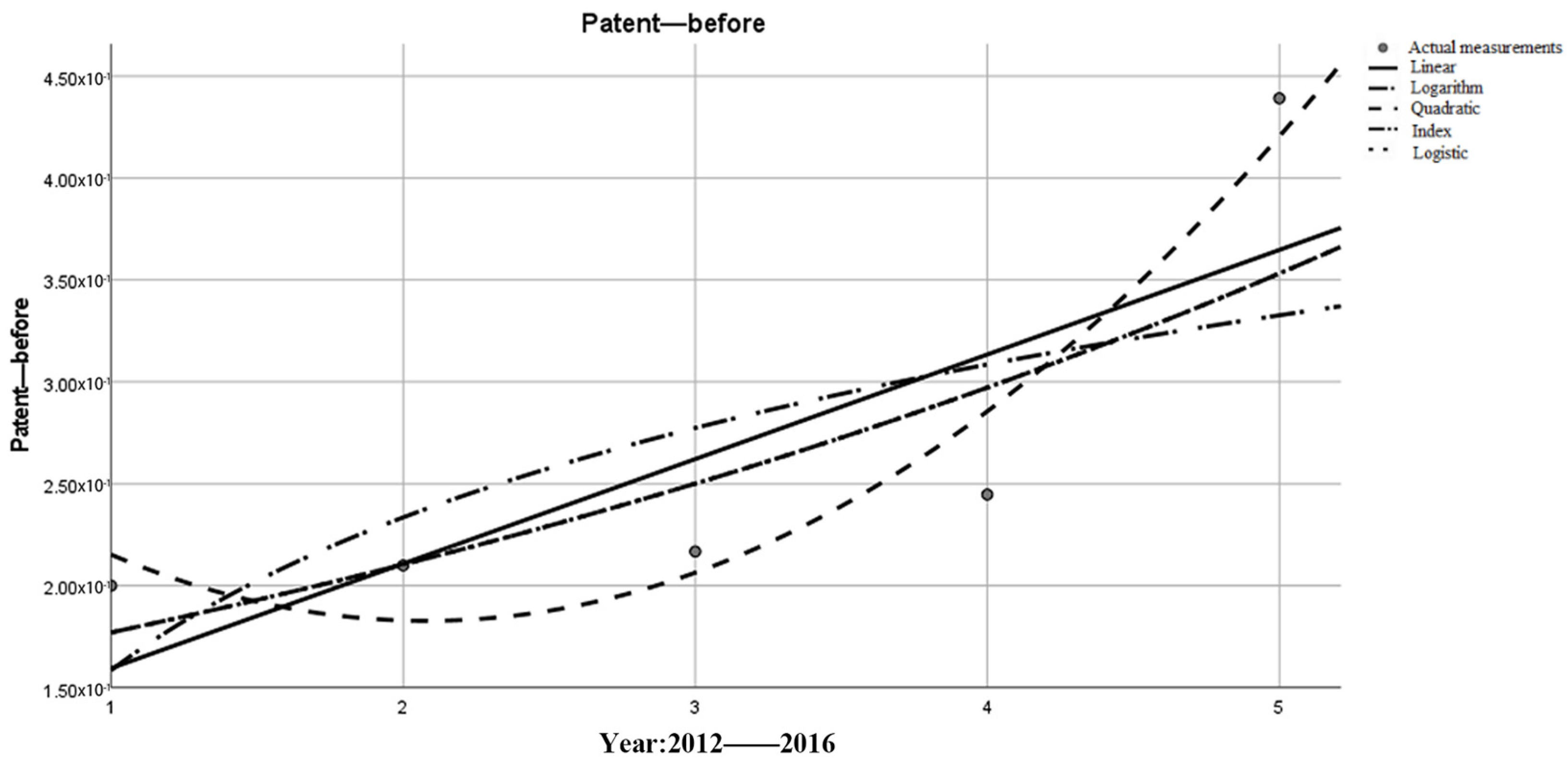

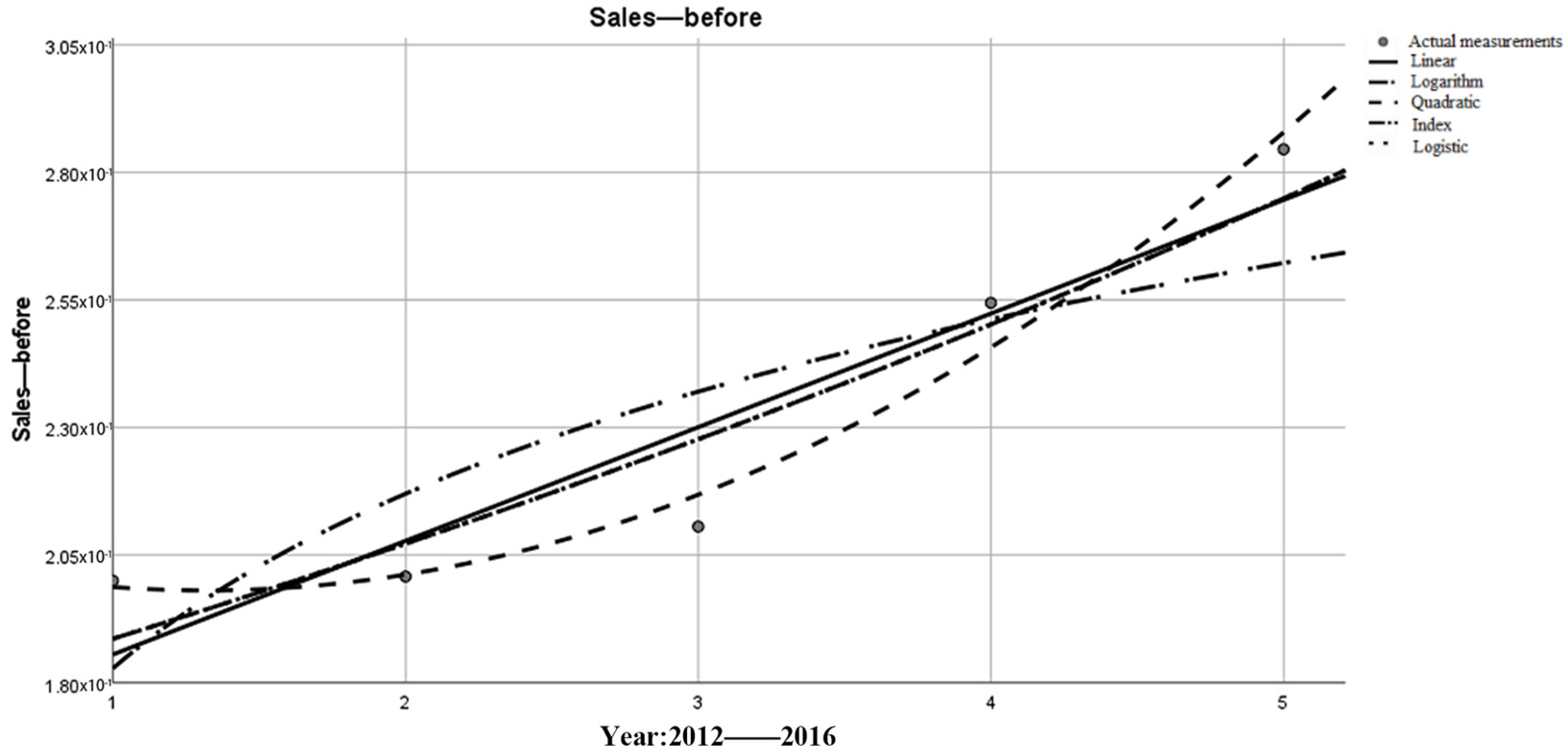
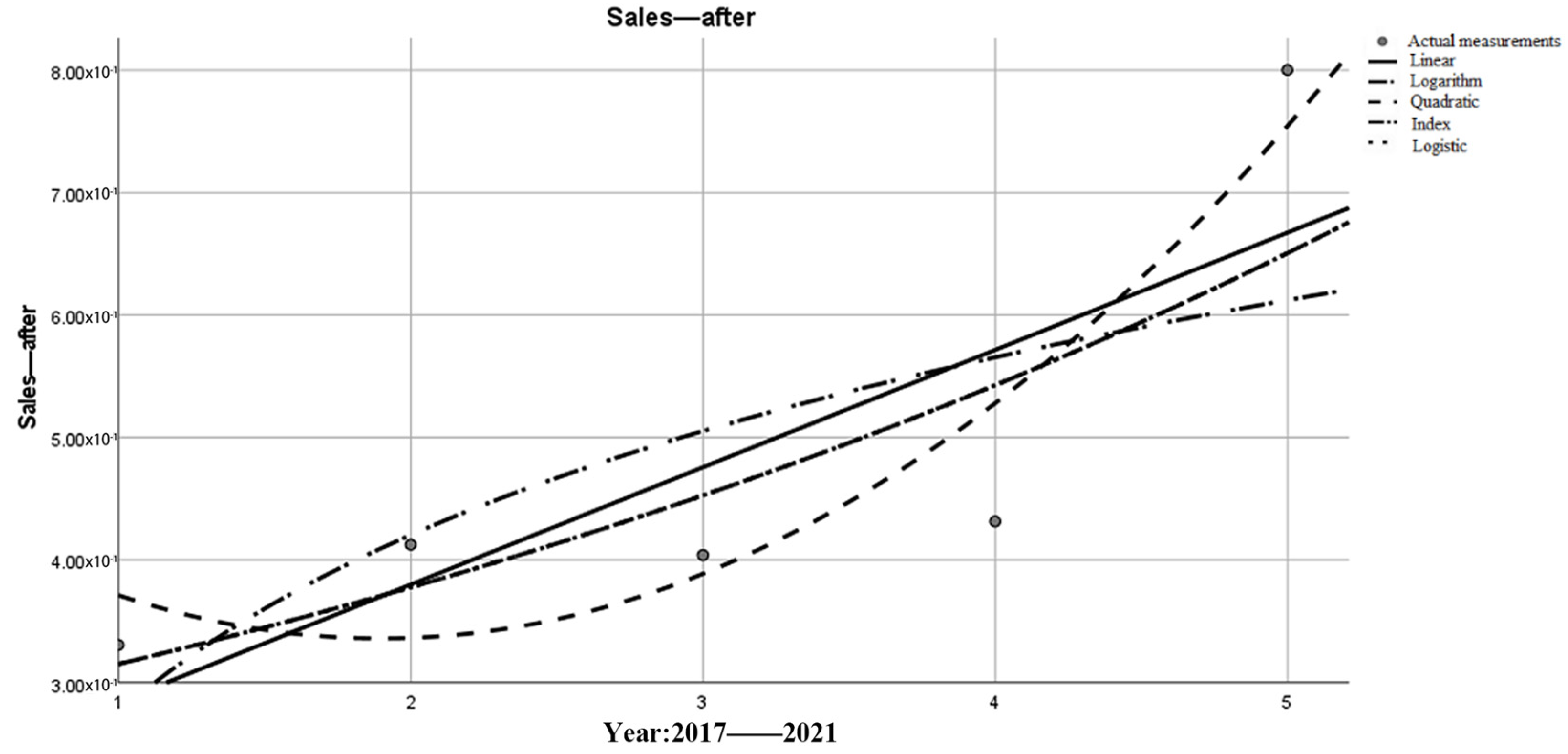
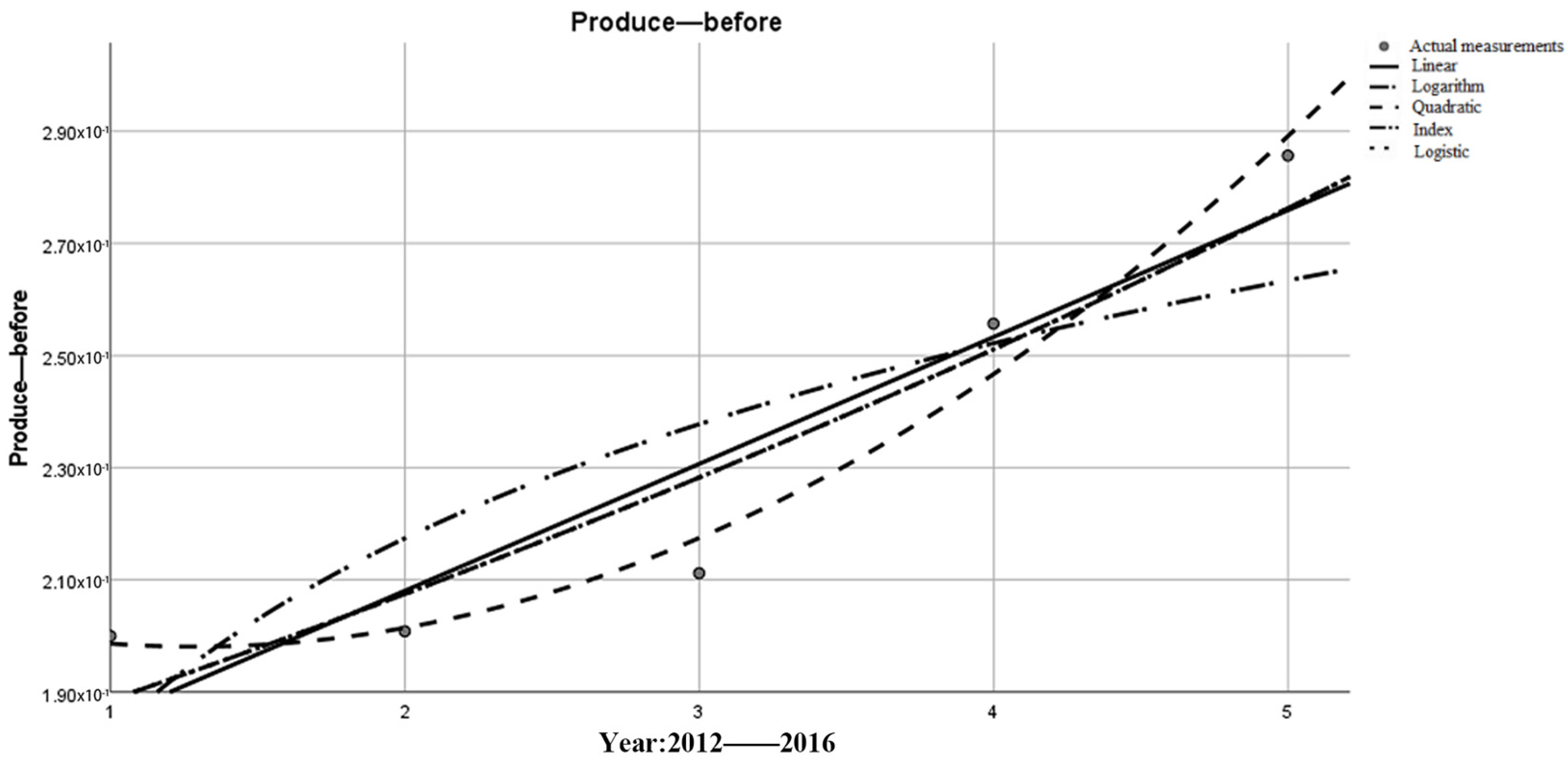
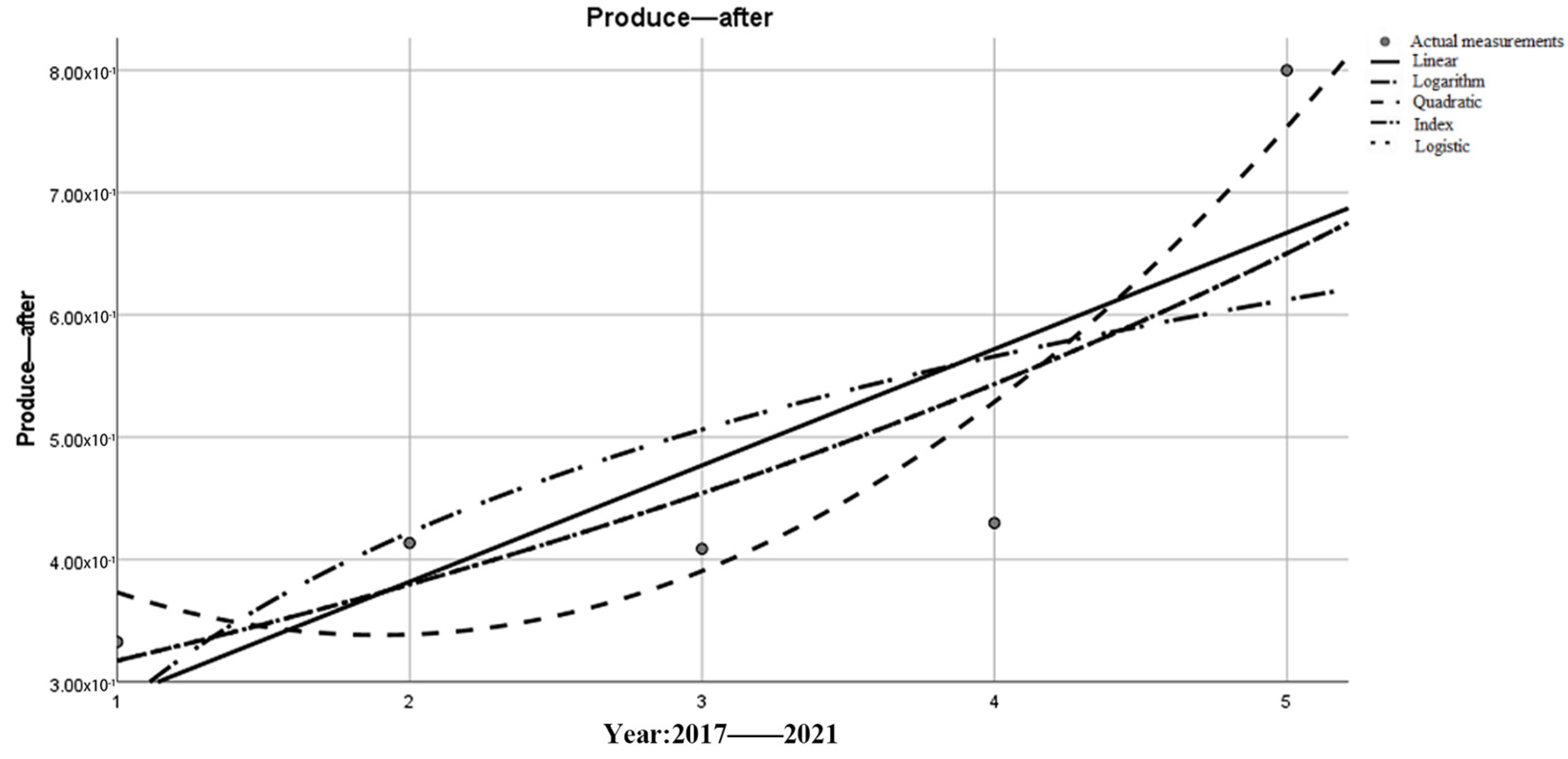
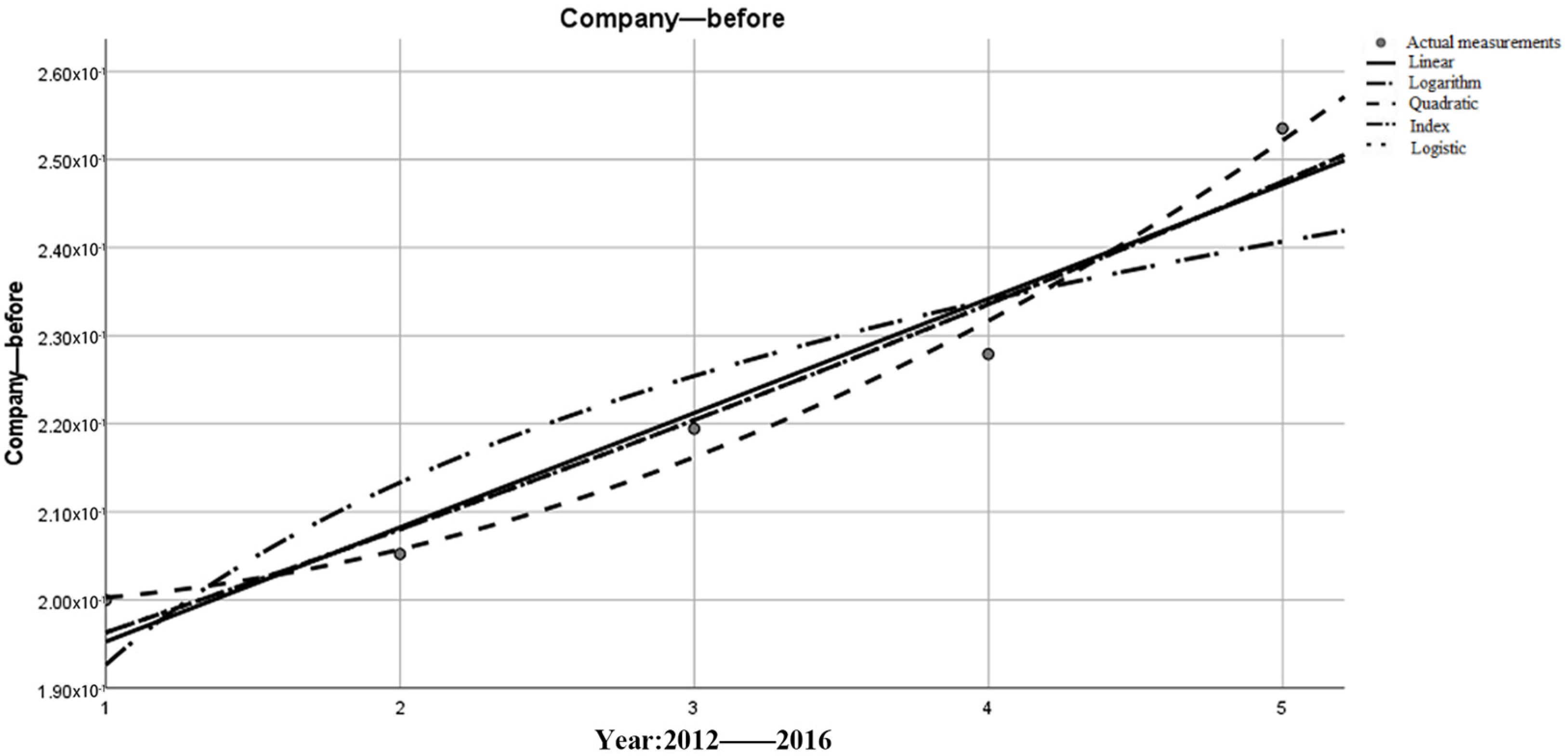


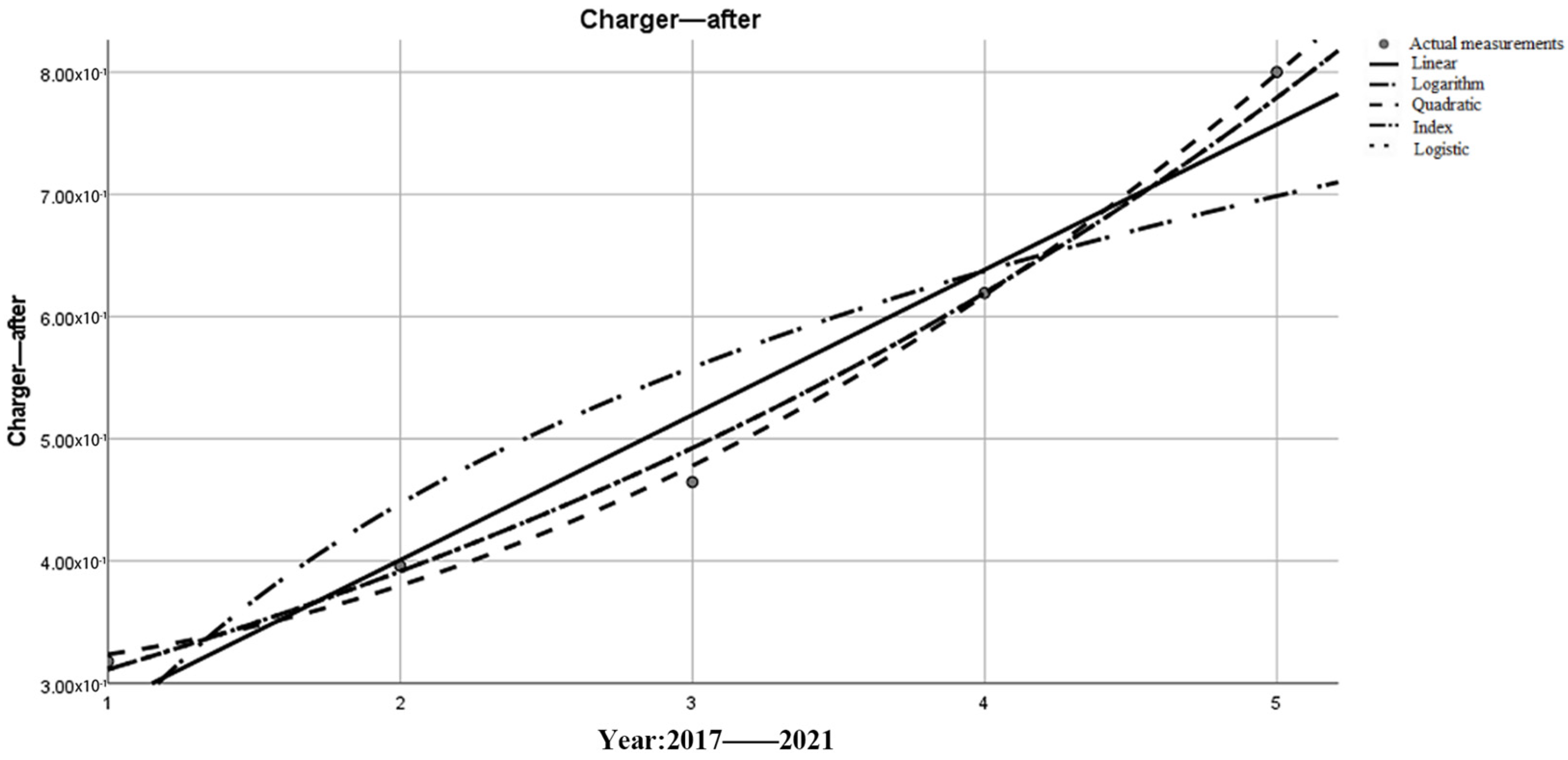
| Symbols | Meaning |
|---|---|
| before | |
| after | |
| time | |
| Pre-policy patent growth | |
| Patent growth after the policy | |
| Pre-policy sales volume growth | |
| Sales growth after the policy | |
| Pre-policy production growth | |
| Production growth after the policy | |
| Pre-policy new business growth | |
| New business growth after the policy | |
| Pre-policy charging pile growth | |
| Charging pile growth after the policy | |
| Minimum value | |
| Maximum value | |
| Indicator data for the year | |
| Patent probability distribution before policy implementation | |
| Patent probability distribution after policy implementation | |
| Probability distribution of sales volume (units) before policy implementation | |
| Probability distribution of sales volume (units) after policy implementation | |
| Probability distribution of production (units) before policy implementation | |
| Probability distribution of production (units) after policy implementation | |
| Probability distribution of the number of newly established companies before the policy was implemented | |
| Probability distribution of the number of newly established companies after the policy was implemented | |
| Probability distribution of the number of charging posts before the policy was implemented | |
| Probability distribution of the number of charging posts after the policy is implemented | |
| Comparative data by year before and after the policy | |
| CPTI | Dual Credit Policy Taylor expansion index |
| CPCEI | Dual Credit Policy Cross-Entropy index |
| Patents | Sales Volume (Units) | Production (Volume) | Number of Newly Established Companies | Number of Charging Piles | |
|---|---|---|---|---|---|
| 2012 | 27 | 12,800 | 12,600 | 2491 | 18,000 |
| 2013 | 43 | 17,600 | 17,500 | 3102 | 22,528 |
| 2014 | 54 | 74,800 | 78,500 | 4766 | 31,000 |
| 2015 | 99 | 331,100 | 340,500 | 5758 | 49,000 |
| 2016 | 412 | 507,000 | 517,000 | 8755 | 141,000 |
| 2017 | 233 | 777,000 | 794,000 | 13,442 | 240,000 |
| 2018 | 643 | 1,256,000 | 127,0000 | 21,516 | 387,000 |
| 2019 | 677 | 1,206,000 | 1,242,000 | 23,311 | 516,000 |
| 2020 | 610 | 1,367,000 | 1,366,000 | 32,848 | 807,000 |
| 2021 | 993 | 3,521,000 | 3,545,000 | 72,707 | 1,147,000 |
| Maximum value | 993 | 3,521,000 | 3,545,000 | 72,707 | 1,147,000 |
| Minimum value | 27 | 12,800 | 12,600 | 2491 | 18,000 |
| Average value | 379.1 | 90,7030 | 918,310 | 18,869.6 | 335,852.8 |
| Patents | Sales Volume (Units) | Production (Volume) | Number of Newly Established Companies | Number of Charging Piles | |
|---|---|---|---|---|---|
| 2012 | 0.2 | 0.2 | 0.2 | 0.2 | 0.2 |
| 2013 | 0.210 | 0.201 | 0.201 | 0.205 | 0.202 |
| 2014 | 0.217 | 0.211 | 0.211 | 0.219 | 0.207 |
| 2015 | 0.245 | 0.254 | 0.256 | 0.228 | 0.216 |
| 2016 | 0.439 | 0.285 | 0.286 | 0.254 | 0.265 |
| 2017 | 0.328 | 0.331 | 0.333 | 0.294 | 0.318 |
| 2018 | 0.583 | 0.413 | 0.414 | 0.363 | 0.396 |
| 2019 | 0.604 | 0.404 | 0.409 | 0.378 | 0.465 |
| 2020 | 0.5621 | 0.432 | 0.430 | 0.459 | 0.619 |
| 2021 | 0.8 | 0.8 | 0.8 | 0.8 | 0.8 |
| Square of R | F | Degree of Freedom 1 | Degree of Freedom 2 | Significance | Constants | b1 | b2 | |
|---|---|---|---|---|---|---|---|---|
| Linear | 0.654 | 5.659 | 1 | 3 | 0.098 | 0.108 | 0.051 | |
| Logarithmic | 0.470 | 2.657 | 1 | 3 | 0.202 | 0.158 | 0.108 | |
| Secondary | 0.923 | 12.056 | 2 | 2 | 0.077 | 0.303 | −0.116 | 0.028 |
| Index | 0.712 | 7.423 | 1 | 3 | 0.072 | 0.149 | 0.173 | |
| Logistic | 0.712 | 7.423 | 1 | 3 | 0.072 | 6.712 | 0.841 |
| Square of R | F | Degree of Freedom 1 | Degree of Freedom 2 | Significance | Constants | b1 | b2 | |
|---|---|---|---|---|---|---|---|---|
| Linear | 0.757 | 9.339 | 1 | 3 | 0.055 | 0.298 | 0.092 | |
| Logarithmic | 0.792 | 11.425 | 1 | 3 | 0.043 | 0.350 | 0.235 | |
| Secondary | 0.763 | 3.215 | 2 | 2 | 0.237 | 0.250 | 0.134 | −0.007 |
| Index | 0.727 | 7.996 | 1 | 3 | 0.066 | 0.328 | 0.175 | |
| Logistic | 0.727 | 7.996 | 1 | 3 | 0.066 | 3.053 | 0.840 |
| Square of R | F | Degree of Freedom 1 | Degree of Freedom 2 | Significance | Constants | b1 | b2 | |
|---|---|---|---|---|---|---|---|---|
| Linear | 0.870 | 20.108 | 1 | 3 | 0.021 | 0.163 | 0.022 | |
| Logarithmic | 0.691 | 6.695 | 1 | 3 | 0.081 | 0.183 | 0.049 | |
| Secondary | 0.978 | 43.690 | 2 | 2 | 0.022 | 0.210 | −0.017 | 0.007 |
| Index | 0.881 | 22.188 | 1 | 3 | 0.018 | 0.172 | 0.094 | |
| Logistic | 0.881 | 22.188 | 1 | 3 | 0.018 | 5.825 | 0.910 |
| Square of R | F | Degree of Freedom 1 | Degree of Freedom 2 | Significance | Constants | b1 | b2 | |
|---|---|---|---|---|---|---|---|---|
| Linear | 0.668 | 6.039 | 1 | 3 | 0.091 | 0.189 | 0.096 | |
| Logarithmic | 0.515 | 3.186 | 1 | 3 | 0.172 | 0.276 | 0.209 | |
| Secondary | 0.861 | 6.202 | 2 | 2 | 0.139 | 0.493 | −0.165 | 0.044 |
| Index | 0.735 | 8.322 | 1 | 3 | 0.063 | 0.263 | 0.181 | |
| Logistic | 0.735 | 8.322 | 1 | 3 | 0.063 | 3.803 | 0.834 |
| Square of R | F | Degree of Freedom 1 | Degree of Freedom 2 | Significance | Constants | b1 | b2 | |
|---|---|---|---|---|---|---|---|---|
| Linear | 0.873 | 20.610 | 1 | 3 | 0.020 | 0.163 | 0.023 | |
| Logarithmic | 0.694 | 6.819 | 1 | 3 | 0.080 | 0.183 | 0.050 | |
| Secondary | 0.977 | 42.568 | 2 | 2 | 0.023 | 0.209 | −0.017 | 0.007 |
| Index | 0.884 | 22.791 | 1 | 3 | 0.017 | 0.171 | 0.095 | |
| Logistic | 0.884 | 22.791 | 1 | 3 | 0.017 | 5.834 | 0.909 |
| Square of R | F | Degree of Freedom 1 | Degree of Freedom 2 | Significance | Constants | b1 | b2 | |
|---|---|---|---|---|---|---|---|---|
| Linear | 0.665 | 5.945 | 1 | 3 | 0.093 | 0.192 | 0.095 | |
| Logarithmic | 0.513 | 3.156 | 1 | 3 | 0.174 | 0.278 | 0.208 | |
| Secondary | 0.856 | 5.964 | 2 | 2 | 0.144 | 0.494 | −0.164 | 0.043 |
| Index | 0.731 | 8.134 | 1 | 3 | 0.065 | 0.265 | 0.179 | |
| Logistic | 0.731 | 8.134 | 1 | 3 | 0.065 | 3.770 | 0.836 |
| Square of R | F | Degree of Freedom 1 | Degree of Freedom 2 | Significance | Constants | b1 | b2 | |
|---|---|---|---|---|---|---|---|---|
| Linear | 0.936 | 44.106 | 1 | 3 | 0.007 | 0.182 | 0.013 | |
| Logarithmic | 0.801 | 12.063 | 1 | 3 | 0.040 | 0.193 | 0.030 | |
| Secondary | 0.985 | 66.011 | 2 | 2 | 0.015 | 0.200 | −0.002 | 0.003 |
| Index | 0.951 | 58.204 | 1 | 3 | 0.005 | 0.185 | 0.058 | |
| Logistic | 0.951 | 58.204 | 1 | 3 | 0.005 | 5.397 | 0.944 |
| Square of R | F | Degree of Freedom 1 | Degree of Freedom 2 | Significance | Constants | b1 | b2 | |
|---|---|---|---|---|---|---|---|---|
| Linear | 0.772 | 10.154 | 1 | 3 | 0.050 | 0.126 | 0.111 | |
| Logarithmic | 0.605 | 4.599 | 1 | 3 | 0.121 | 0.225 | 0.244 | |
| Secondary | 0.938 | 15.182 | 2 | 2 | 0.062 | 0.430 | −0.150 | 0.044 |
| Index | 0.865 | 19.151 | 1 | 3 | 0.022 | 0.220 | 0.224 | |
| Logistic | 0.865 | 19.151 | 1 | 3 | 0.022 | 4.551 | 0.799 |
| Square of R | F | Degree of Freedom 1 | Degree of Freedom 2 | Significance | Constants | b1 | b2 | |
|---|---|---|---|---|---|---|---|---|
| Linear | 0.714 | 7.496 | 1 | 3 | 0.071 | 0.175 | 0.014 | |
| Logarithmic | 0.527 | 3.349 | 1 | 3 | 0.165 | 0.189 | 0.031 | |
| Secondary | 0.948 | 18.239 | 2 | 2 | 0.052 | 0.224 | −0.028 | 0.007 |
| Index | 0.738 | 8.447 | 1 | 3 | 0.062 | 0.179 | 0.063 | |
| Logistic | 0.738 | 8.447 | 1 | 3 | 0.062 | 5.572 | 0.939 |
| Square of R | F | Degree of Freedom 1 | Degree of Freedom 2 | Significance | Constants | b1 | b2 | |
|---|---|---|---|---|---|---|---|---|
| Linear | 0.956 | 64.743 | 1 | 3 | 0.004 | 0.163 | 0.119 | |
| Logarithmic | 0.826 | 14.196 | 1 | 3 | 0.033 | 0.257 | 0.275 | |
| Secondary | 0.997 | 310.703 | 2 | 2 | 0.003 | 0.309 | −0.006 | 0.021 |
| Index | 0.991 | 337.811 | 1 | 3 | 0.000 | 0.248 | 0.229 | |
| Logistic | 0.991 | 337.811 | 1 | 3 | 0.000 | 4.038 | 0.795 |
| Coefficient Matrix before Compound Weighting | Fifth Order Pole Number | Forth Order Pole Number | Third Order Pole Number | Secord Order Pole Number | First Order Pole Number | Constant Term |
|---|---|---|---|---|---|---|
| Patents-before | 0.000 | 0.000 | 0.000 | 0.010 | −0.143 | 1.000 |
| Patents-after | 0.000 | 0.000 | −0.001 | 0.013 | −0.159 | 1.000 |
| Sales-before | −0.002 | 0.011 | −0.062 | 0.258 | −0.719 | 1.000 |
| Sales-after | 0.000 | 0.000 | 0.000 | 0.006 | −0.105 | 1.000 |
| Production-before | −0.002 | 0.012 | −0.064 | 0.265 | −0.729 | 1.000 |
| Production-after | 0.000 | 0.000 | 0.000 | 0.005 | −0.103 | 1.000 |
| Companies-before | 0.000 | 0.000 | 0.000 | 0.009 | −0.136 | 1.000 |
| Companies-after | 0.000 | 0.000 | −0.001 | 0.014 | −0.167 | 1.000 |
| Charging-before | 0.000 | 0.002 | −0.017 | 0.111 | −0.471 | 1.000 |
| Charging-after | 0.000 | 0.000 | 0.000 | 0.010 | −0.139 | 1.000 |
| Coefficient Matrix before Compound Weighting | Fifth Order Pole Number | Forth Order Pole Number | Third Order Pole Number | Secord Order Pole Number | First Order Pole Number | Relative Growth Index |
|---|---|---|---|---|---|---|
| Patents-before | 0.000 | 0.000 | 0.000 | 0.005 | −0.143 | −0.138 |
| Patents-after | 0.000 | 0.000 | 0.000 | 0.006 | −0.159 | −0.153 |
| Sales-before | 0.000 | 0.003 | −0.021 | 0.129 | −0.719 | −0.610 |
| Sales-after | 0.000 | 0.000 | 0.000 | 0.003 | −0.105 | −0.102 |
| Production-before | 0.000 | 0.003 | −0.021 | 0.133 | −0.729 | −0.617 |
| Production-after | 0.000 | 0.000 | 0.000 | 0.003 | −0.103 | −0.101 |
| Companies-before | 0.000 | 0.000 | 0.000 | 0.005 | −0.136 | −0.131 |
| Companies-after | 0.000 | 0.000 | 0.000 | 0.007 | −0.167 | −0.161 |
| Charging-before | 0.000 | 0.001 | −0.006 | 0.055 | −0.471 | −0.421 |
| Charging-after | 0.000 | 0.000 | 0.000 | 0.005 | −0.139 | −0.134 |
| Policy Impact Indicators | Patents | Sales Volume (Units) | Production (Volume) | Number of Newly Established Companies | Number of Charging Piles |
|---|---|---|---|---|---|
| Policy Impact Factor | 0.904 | 5.964 | 6.135 | 0.816 | 3.142 |
| Indicator Category | Patents | Sales Volume (Units) | Production (Volume) | Number of Newly Established Companies | Number of Charging Piles |
|---|---|---|---|---|---|
| Comparative data by year before and after the policy | 0.223 | 0.221 | 0.220 | 0.245 | 0.229 |
| 0.113 | 0.1778 | 0.177 | 0.208 | 0.187 | |
| 0.109 | 0.191 | 0.189 | 0.214 | 0.159 | |
| 0.141 | 0.214 | 0.216 | 0.177 | 0.104 | |
| 0.0980 | 0.0635 | 0.0637 | 0.057 | 0.059 |
| Patents | Sales Volume (Units) | Production (Volume) | Number of Newly Established Companies | Number of Charging Piles | |
|---|---|---|---|---|---|
| Dual Credit Policy affects Cross-Entropy index | 0.685 | 0.867 | 0.866 | 0.901 | 0.738 |
Disclaimer/Publisher’s Note: The statements, opinions and data contained in all publications are solely those of the individual author(s) and contributor(s) and not of MDPI and/or the editor(s). MDPI and/or the editor(s) disclaim responsibility for any injury to people or property resulting from any ideas, methods, instructions or products referred to in the content. |
© 2023 by the authors. Licensee MDPI, Basel, Switzerland. This article is an open access article distributed under the terms and conditions of the Creative Commons Attribution (CC BY) license (https://creativecommons.org/licenses/by/4.0/).
Share and Cite
Qiao, J.; Yang, S.; Zhao, J.; Li, H.; Fan, Y. A Quantitative Study on the Impact of China’s Dual Credit Policy on the Development of New Energy Industry Based on Taylor Expansion Description and Cross-Entropy Theory. World Electr. Veh. J. 2023, 14, 295. https://doi.org/10.3390/wevj14100295
Qiao J, Yang S, Zhao J, Li H, Fan Y. A Quantitative Study on the Impact of China’s Dual Credit Policy on the Development of New Energy Industry Based on Taylor Expansion Description and Cross-Entropy Theory. World Electric Vehicle Journal. 2023; 14(10):295. https://doi.org/10.3390/wevj14100295
Chicago/Turabian StyleQiao, Jiantong, Shangru Yang, Jiaming Zhao, Haoyuan Li, and Yuezhen Fan. 2023. "A Quantitative Study on the Impact of China’s Dual Credit Policy on the Development of New Energy Industry Based on Taylor Expansion Description and Cross-Entropy Theory" World Electric Vehicle Journal 14, no. 10: 295. https://doi.org/10.3390/wevj14100295
APA StyleQiao, J., Yang, S., Zhao, J., Li, H., & Fan, Y. (2023). A Quantitative Study on the Impact of China’s Dual Credit Policy on the Development of New Energy Industry Based on Taylor Expansion Description and Cross-Entropy Theory. World Electric Vehicle Journal, 14(10), 295. https://doi.org/10.3390/wevj14100295





